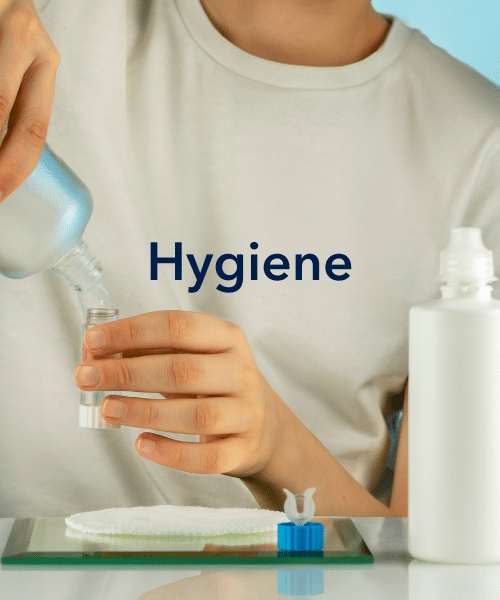This post is a general guideline. Always work with your eye care doctor to ensure you are following the protocols recommended for you.
Scleral lenses have become increasingly popular in recent years due to their ability to provide clear vision and comfort for individuals with certain eye conditions. These lenses cover a larger portion of the eye, resting on the sclera, and are used to correct a variety of vision issues, including astigmatism and keratoconus. However, to ensure the safety and effectiveness of scleral lenses, proper hygiene practices are essential. In this guide, we will highlight the crucial steps for maintaining optimal scleral lens hygiene.
Preparation
- Wash Your Hands Thoroughly: Before handling your scleral lenses, it is imperative to wash your hands with a mild, fragrance-free soap. This helps eliminate any potential dirt, oils, or bacteria that may transfer to the lenses and, subsequently, to your eyes. Dry your hands with a lint-free towel to avoid fibers coming into contact with the lenses.
- Use a Clean and Controlled Environment: Choose a well-lit, clean, and clutter-free area for handling your scleral lenses. Be sure the surface is dry and that you have all the necessary cleaning and disinfecting solutions within reach. A bathroom counter or a dedicated space in your bedroom can serve as a suitable location. We recommend placing a towel on the surface, that way, if you drop your lens it will be easier to see and less likely to scratch or break.
Cleaning
Cleaning your scleral lenses is a multi-step process involving a variety of solutions. You will need a cleaning/disinfection solution, preservative-free saline, and, if recommended, a general rinsing solution.
- Download the Healthy Lens Habits Guide (your doctor can write in the recommended solutions) or Lens Solutions page (your doctor can circle the recommended solutions).
- Rub and Rinse: Begin by applying the disinfecting solution recommended by your eye care doctor to rinse off any debris or protein buildup on the lenses. GENTLY rub the lenses with your fingertips, ensuring all surfaces are clean.
- Disinfect for 6+ hours: Many eye care doctors recommend disinfecting scleral lenses with a hydrogen peroxide-based solution. Peroxide solutions offer a deep clean, eliminating harmful microorganisms. Follow the specific instructions provided with your peroxide system, ensuring the lenses are neutralized before inserting them into your eyes. It takes 6+ hours minimum for scleral lenses to complete a cleaning and disinfection process.
Insertion
When inserting your scleral lenses, use a preservative-free saline solution to rinse first. This helps ensure that no harsh chemicals or preservatives come into direct contact with your eyes, minimizing the risk of irritation.
Fill the bowl of your scleral lens with preservative-free saline solution only.
Your Lens Case
Regularly clean and replace your lens case to prevent the growth of bacteria. Rinse the case with preservative-free saline solution, air-dry it upside down on a clean tissue, and store it in a cool, dry place.
Regular Check-ups
Schedule regular appointments with your eye care doctor to monitor the health of your eyes and the condition of your scleral lenses. They can guide necessary adjustments to your cleaning routine or lens prescription.
Proper scleral lens hygiene is essential for maintaining eye health and optimizing vision. By following these steps diligently and adhering to the recommendations of your eye care doctor, you can enjoy the benefits of scleral lenses while minimizing the risk of complications. Consistency and attention to detail are key to ensuring a safe and comfortable experience with scleral lenses.
